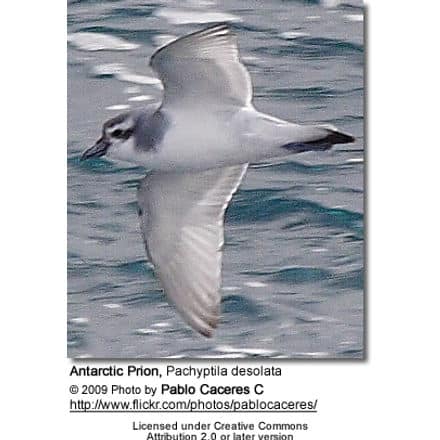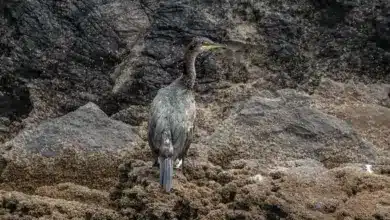Antarctic Prions
The Antarctic Prions, Pachyptila desolata, also known as the Totorore in Maori, is the largest of the prions, a genus of small petrels of the Southern Ocean.

Sub-species
The Antarctic Prion has sub-species.
- Pachyptila desolata desolata, the nominate race, breeds on the Crozet Islands, Kerguelen Islands, and Macquarie Island
- Pachyptila desolata altera, breeds on Heard Island and the Auckland Islands
- Pachyptila desolata banksi, breeds on the Scotia Archipelago, South Georgia, South Sandwich Islands, and Scott Island
Description
The wingspan is 17 to 20 cm (6.7 to 7.9 in), and the body length is 28 cm (11 in).
Like all prions, its underparts are white and upperparts are blue-grey, with a dark “M” across its back to its wingtips. It has a white eyebrow, blue-grey bill, and blue feet. It also has a grey wedge-shaped tail with a black tip. On its wings, its greater coverts are near black.
Feeding
Like all prions, the Antarctic Prion eat primarily zooplankton, which it obtains by filtering water through its upper bill.
Breeding
The Antarctic Petrel nests in colonies, and prefer islands in the southern oceans. Both sexes assist in building the nest, as well as incubating the single egg and raising the chick.
Range and habitat
It breeds in colonies on Auckland Island, Heard Island, Macquarie Island, Scott Island, the South Georgia and the South Sandwich Islands, the South Orkney Islands, the South Shetland Islands, the Crozet Islands, and the Kerguelen Islands.
When not breeding, this bird ranges throughout the southern oceans.
Conservation
The Antarctic Petrel has an occurrence range of 76,600,000 km2 (29,600,000 sq mi) and an estimated adult bird population of 50,000,000.
Etymology
Pachyptila, the word, comes from the Greek words pakhus and ptilon. Pakhus means thick or stout and ptilon means a feather. Desolatus is Latin for forsaken or desolate. This is in reference to the desolate Antarctic region where they live. Also from the Greek language, Prion comes from the word pri?n meaning a saw, which is in reference to its serrated edges of its bill.
Taxonomy
The Antarctic Prion is a member of the Pachyptila genus, and along with the Pachyptila makes up the Prions. They in turn are members of the Procellariidae family, and the Procellariiformes order.
The prions are small and typically eat just zooplankton; however as a member of the Procellariiformes, they share certain identifying features. First, they have nasal passages that attach to the upper bill called naricorns. Although the nostrils on the Prion are on top of the upper bill. The bills of Procellariiformes are also unique in that they are split into between 7 and 9 horny plates. They produce a stomach oil made up of wax esters and triglycerides that is stored in the proventriculus (stomach). This is used against predators as well as an energy rich food source for chicks and for the adults during their long flights. Finally, they also have a salt gland that is situated above the nasal passage and helps desalinate their bodies, due to the high amount of ocean water that they imbibe. It excretes a high saline solution from their nose.






